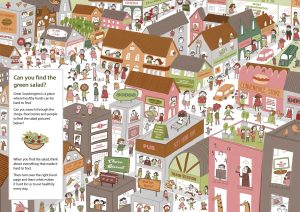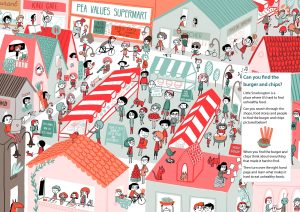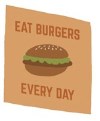In the twin villages of Great and Little Snackington, much like communities everywhere, food is an important part of everyday life. But does where we live, work and play shape what we eat?

Great Snackington is a community where healthy food can be hard to find.
The neighbouring community of Little Snackingon is a place where unhealthy food is hard to find.
Explore each village for the hidden food – just click on the images below. In Great Snackington, you’re looking for the green salad. In Little Snackington you’re looking for the burger and chips.
While you hunt for the food, you’ll learn what researchers are discovering about how our food choices are shaped by where we live, work and play. Many of these influences can work together to shape our food choices over time, making our overall diets unhealthy and increasing our risk of diet related diseases.
You will also learn how scientists study what people eat and why, while we don’t wear white lab coats – the world is our laboratory!
Great SnackingtonCan you find the green salad? |
Little SnackingtonCan you find the burger and chips? |
 |
 |
| Download Great Snackington as a jpg | Download Little Snackington as a jpg |
The science – did you spot the many influences on what we eat?
Researchers have been studying many aspects of why people eat what they eat, and what we can do to make it easier for everyone to eat healthy meals throughout the day. Everything from food prices, promotions, advertising and density of takeaways can influence our diet and health.
Below are pictures of the some of the things you might have seen in Great and Little Snackington, together with information about how they influence what we eat.
There are also links to scientific papers and more resources on each of these topics, if you, your parents or teachers want to do any further reading.
Printed copies of Great Snackington and Little Snackington are also available. If you would like copies, please email comms@mrc-epid.cam.ac.uk. You can also contact us if you would like a researcher to visit your school to talk about this subject.
 Advertising
Advertising
Did you notice that Great Snackington has a lot of outdoor and TV food advertising? This has been shown to influence our food choices. The more food advertising children see, the more unhealthily they eat.
Find out more:
- Effect of Restrictions on Television Food Advertising to Children on Exposure to Advertisements for ‘Less Healthy’ Foods: Repeat Cross-Sectional Study PLOS ONE 2012
- Do television food advertisements portray advertised foods in a healthy food context? British Journal of Nutrition, 2011
- Socio-economic differences in exposure to television food advertisements in the UK: a cross-sectional study of advertisements broadcast in one television region. Public Health Nutrition, 2011
Portion sizes
The portion size of what we eat can influences how much of it we eat, or whether we think it is a good value for money.
Find out more:
- Portion, package or tableware size for changing selection and consumption of food, alcohol and tobacco. The Cochrane Database of Systematic Reviews, 2015
Food prices
Did you notice that Little Snackington has lots of stores selling healthy affordable food? If healthy  foods are too expensive, we tend not to choose them. If healthy foods are on promotion at supermarkets, we might be more likely to choose them.
foods are too expensive, we tend not to choose them. If healthy foods are on promotion at supermarkets, we might be more likely to choose them.
Find out more:
- Interactive – Explore 13 years of food price changes
- CEDAR Evidence Brief 2014 – Financial hardships, diet & obesity
- Dietary Diversity, Diet Cost, and Incidence of Type 2 Diabetes in the United Kingdom: A Prospective Cohort Study. PLOS Medicine, 2016
- Does the importance of dietary costs for fruit and vegetable intake vary by socioeconomic position? British Journal of Nutrition, 2015
- The Growing Price Gap between More and Less Healthy Foods: Analysis of a Novel Longitudinal UK Dataset, PLOS One, 2014
Product promotions
 If unhealthy foods are on promotion, it can encourage us to choose them instead. While supermarkets sell lots of healthy food, they also sell food that isn’t so good for you. The unhealthy food is often displayed near checkouts to encourage us to buy it on our way out.
If unhealthy foods are on promotion, it can encourage us to choose them instead. While supermarkets sell lots of healthy food, they also sell food that isn’t so good for you. The unhealthy food is often displayed near checkouts to encourage us to buy it on our way out.
Find out more:
- Price promotions on healthier compared with less healthy foods: a hierarchical regression analysis of the impact on sales and social patterning of responses to promotions in Great Britain. The American Journal of Clinical Nutrition, 2015
- The proportion of unhealthy foodstuffs children are exposed to at the checkout of convenience supermarkets. Public Health Nutrition, 2015
 Takeaways
Takeaways
If we have lots of opportunities to choose a takeaway shop, we tend to eat more takeaway food and weigh more. Takeaways can often cluster more around schools!
Preparing and eating meals at home is not always possible, and we are eating on the go more and more. If cafes and takeaway shops had lots of healthy options, eating healthily while away from home would be easier.
Find out more:
- CEDAR Evidence Brief 2014 – Are Takeaways adding pounds?
- MRC Epidemiology Unit News blog 2016 – Local takeaways create a double burden for obesity
- Utilization of Away-From-Home Food Establishments, Dietary Approaches to Stop Hypertension Dietary Pattern, and Obesity. American Journal of Preventive Medicine, 2017
- Frequency and socio-demographic correlates of eating meals out and take-away meals at home: cross-sectional analysis of the UK national diet and nutrition survey, waves 1–4 (2008–12) International Journal of Behavioral Nutrition and Physical Activity, 2015
- Associations between Food Outlets around Schools and BMI among Primary Students in England: A Cross-Classified Multi-Level Analysis. PLOS ONE 2015
- Associations between exposure to takeaway food outlets, takeaway food consumption, and body weight in Cambridgeshire, UK: population based, cross sectional study. BMJ, 2014
- Healthier catering initiatives in London, UK: an effective tool for encouraging healthier consumption behaviour? Critical Public Health, 2013
- Impact of neighbourhood food environment on food consumption in children aged 9–10 years in the UK SPEEDY (Sport, Physical Activity and Eating behaviour: Environmental Determinants in Young people) study. Public Health Nutrition, 2010
 School food
School food
Food sold in schools is not always as healthy as it could be, either from the cafeteria or from vending machines. having more healthy options at school might help.
Find out more:
- CEDAR Evidence Brief 2012 – Children’s diet and schools
- Changes in diet from age 10 to 14 years and prospective associations with school lunch choice. Appetite, 2017
- The Impact of the Availability of School Vending Machines on Eating Behavior during Lunch: The Youth Physical Activity and Nutrition Survey. Journal of the American Dietetic Association, 2010
Lack of time
 Lack of time makes it harder for us to eat healthy food. Rushing to work, or taking care of kids or parents, can make it harder to eat healthily.
Lack of time makes it harder for us to eat healthy food. Rushing to work, or taking care of kids or parents, can make it harder to eat healthily.
Find out more:
- Time scarcity and food choices: an overview. Appetite, 2006
- Time Spent on Home Food Preparation and Indicators of Healthy Eating. American Journal of Preventive Medicine, 2014
Cooking skills
 Having the time and ability to cook at home can influence which foods we choose, if cooking is not something we do often we may be more likely to choose a ready meal or take away. Eating foods prepared at home could help us to eat more healthily.
Having the time and ability to cook at home can influence which foods we choose, if cooking is not something we do often we may be more likely to choose a ready meal or take away. Eating foods prepared at home could help us to eat more healthily.
Find out more:
- Prevalence and socio-demographic correlates of cooking skills in UK adults: cross-sectional analysis of data from the UK National Diet and Nutrition Survey. International Journal of Behavioral Nutrition and Physical Activity, 2015
Sweet foods
 Children and young people tend to like sweeter food than adults, and this can make it more difficult to say no to the many sugary foods that are all around us.
Children and young people tend to like sweeter food than adults, and this can make it more difficult to say no to the many sugary foods that are all around us.
Find out more:
- Taste and Food Choices. Present Knowledge in Nutrition, 2012
Who does the science – did you spot the scientists?
 Dietary Public Health scientists at the MRC Epidemiology Unit and Centre for Diet and Activity Research (CEDAR) study why we eat what we eat. While many scientists work in a laboratory, we do our work out in the community.
Dietary Public Health scientists at the MRC Epidemiology Unit and Centre for Diet and Activity Research (CEDAR) study why we eat what we eat. While many scientists work in a laboratory, we do our work out in the community.
We collect information about where food shops are in our neighbourhoods, what they sell, and for how much. Then we crunch the numbers! We also talk to people to understand why they are making the choices they make.
By understanding what people eat and why, we can help our communities become places where it is easier to eat food that is good for us and lead healthier lives.
- Read more about the Population Health Interventions programme and their research in this area.
- Explore more evidence resources in dietary public health
Great Snackington’s creators
Great Snackington was developed by CEDAR scientist Dr Tarra Penney and Cambridge artist Aurora Cacciapuoti.

 MRC Epidemiology Unit
MRC Epidemiology Unit